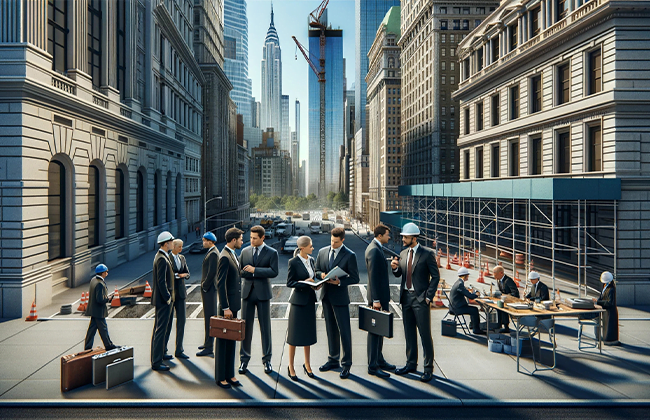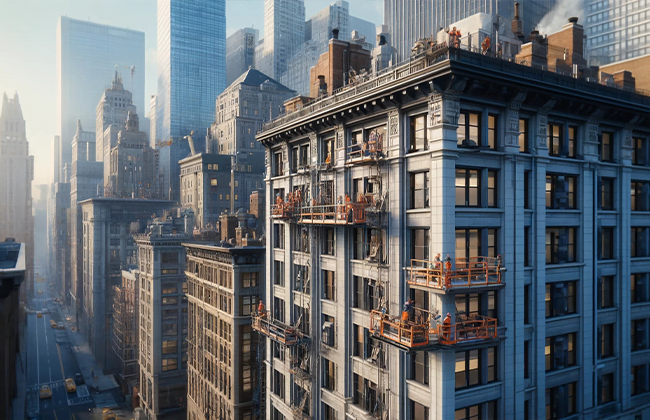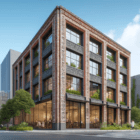Local law 11 facade repair is essential for building owners in New York City to maintain the safety and integrity of their buildings. This law mandates that buildings taller than six stories undergo periodic inspections to ensure their exteriors are in good condition. By complying with local law 11 facade repair requirements, building owners can avoid hefty fines and ensure their properties remain safe and sound for occupants and pedestrians alike.
Table of Contents
What is Local Law 11?
Local Law 11 is a critical regulation in New York City, focusing on the safety of building facades. If you own a building taller than six stories in the city, this law applies to you. Every five years, your building’s exterior needs a thorough check to ensure everything is up to scratch and safe. This isn’t just about ticking a box for the sake of compliance; it’s about making sure no bits of your building end up unexpectedly on the sidewalk, posing risks to pedestrians.
History and Evolution of Local Law 11
It all started back in 1980 with what was then called Local Law 10. The catalyst for this law was a real tragedy—a pedestrian was fatally injured by falling debris from a building. To prevent such incidents, the city decided that buildings needed regular checking and maintenance. Over the years, the regulations have become stricter, transforming into what we now know as Local Law 11. This evolution marks a commitment to improving public safety and taking proactive steps to manage urban infrastructure risks.
The Importance of Regular Facade Inspection
Why bother with regular inspections? Well, first off, it’s the law. But more importantly, these inspections are a key defense against potential accidents. Buildings age, materials deteriorate, and what might seem minor wear and tear can quickly become hazardous. By identifying issues early, you’re not just complying with the law; you’re actively preventing accidents and safeguarding lives. Plus, regular maintenance helps preserve the value of your property—it’s a win-win situation.
Understanding the Inspection Process
The process of inspecting a building under Local Law 11 is meticulous and requires a systematic approach to ensure every part of the building’s exterior meets safety standards. Here’s how it typically unfolds:
1. Initial Assessment
The first step is always about getting a qualified professional on board. This person, usually a licensed architect or engineer, starts with a comprehensive evaluation of your building’s exterior. They’re looking for any signs of wear and tear, structural weaknesses, or potential hazards that could pose risks. It’s a bit like a check-up for your building to catch any issues before they turn into serious problems.
2. Critical Examination
Once the initial assessment is complete, it’s time for a more detailed examination. This isn’t just a simple once-over. The professional might use scaffolding, aerial lifts, or even drones to get up close and personal with parts of the facade that are hard to reach. They’re checking for cracks, rust, loose elements—anything that could indicate a problem. It’s thorough to ensure nothing is missed.
3. Report Filing
After the inspection, the next step is to compile a detailed report. This document goes straight to the Department of Buildings, and it’s pretty important. It outlines everything the inspector found, including the condition of the facade and any repairs that need to be done. Think of it as a report card for your building, letting you know what’s working and what needs fixing.
4. Repair and Maintenance
If the report shows problems, then comes the repair phase. Local Law 11 requires that these repairs be done promptly—no dragging your feet here, as delays can pose safety risks. Once repairs are underway, it’s also crucial to establish a maintenance schedule. Regular checks and minor fixes can prevent big problems down the road, keeping your building in top shape and compliant with the law.
This detailed look at the inspection process should give you a clearer idea of what to expect and how to prepare for Local Law 11 inspections. Remember, the goal here is safety and prevention—keeping your building safe not just for those inside but for everyone around it.
Compliance and Legal Implications

Complying with Local Law 11 is not just a recommendation—it’s a must. If you’re the owner of a building in New York City that’s taller than six stories, sticking to this law isn’t optional. Ignoring it can lead to some serious trouble, including hefty fines and even potential legal action.
What Happens if You Don’t Comply?
Well, let’s just say it’s not great. If you fail to meet the requirements of Local Law 11, the city can impose fines. These fines can be pretty steep, depending on how long you’ve let things slide. Plus, if something goes wrong—say a piece of your facade falls off and causes an injury—you could be looking at lawsuits. Not only could this hurt financially, but it could also damage your reputation significantly.
Why Compliance is Non-Negotiable
Beyond avoiding fines and legal issues, complying with Local Law 11 is about ensuring safety. This law was put in place to prevent accidents that could injure people walking by your building. It’s really about keeping everyone safe—both inside and outside the building.
How to Ensure Compliance
Ensuring compliance with Local Law 11 might seem daunting, but it’s all about staying organized and proactive. Here’s how you can keep everything on track:
Schedule Regular Inspections
Make sure you have a regular schedule for facade inspections. These inspections should be carried out by qualified professionals—licensed architects or engineers who know exactly what to look for. Regular checks mean you’re more likely to catch issues before they become serious problems.
Keep Thorough Records
Document everything. Every inspection report, every repair you make, every interaction with inspectors—keep records of it all. This documentation can be invaluable, especially if you ever need to prove that you’ve been complying with the law.
Address Issues Promptly
If an inspection turns up any problems, don’t drag your feet. Address these issues as soon as possible. Delaying repairs can not only lead to worsening conditions but also increase the risk of fines or legal actions if the problems lead to an accident.
Best Practices for Facade Maintenance
Maintaining your building’s facade isn’t just about complying with Local Law 11; it’s about taking proactive steps to ensure the safety and longevity of your property. Here are some key practices you should adopt to manage facade maintenance effectively:
Regular Monitoring
It’s crucial to keep a close eye on your building’s facade, even outside the mandatory five-year inspection cycles. This ongoing monitoring can help you spot potential issues—like small cracks or water leaks—before they turn into bigger problems. Regular checks can save you a lot of time and money in the long run, as early detection often leads to simpler, less costly repairs.
Use of Technology
In today’s world, technology can be a game-changer in how we maintain and inspect building facades. Using drones for aerial inspections allows you to get a bird’s-eye view of areas that are tough to reach through traditional methods. Drones can capture detailed images and videos, helping inspectors identify issues that might not be visible from the ground. Additionally, digital modeling and 3D scanning technologies can provide you with precise data about your building’s condition, which is invaluable for both current assessments and future maintenance planning.
Expert Consultation
While regular monitoring and technology are important, nothing replaces the expertise of professionals who specialize in facade inspection and repair. These experts not only carry out the mandatory inspections required by Local Law 11 but also offer valuable advice on maintaining your facade effectively. They can help you understand the specific needs of your building based on its age, construction materials, and environmental exposure, guiding you in prioritizing repairs and choosing the right maintenance strategies.
Conclusion
Ensuring your building complies with local law 11 facade repair is not just about following the law—it’s about prioritizing safety and preserving your property’s value. If you are looking for a professional contractor to help with local law 11 facade repair, understand that the right expertise can make all the difference. Feel free to contact us at (+1) 917-355-8556 for reliable and expert service tailored to your needs.
FAQs
Q: What is local law 11 facade repair?
A: Local law 11 facade repair involves periodic inspections and necessary maintenance of building exteriors in NYC to ensure they meet safety standards. Buildings taller than six stories are required to undergo these inspections every five years.
Q: Why is local law 11 facade repair important?
A: Complying with local law 11 facade repair is crucial for ensuring the safety of both pedestrians and building occupants by preventing potential hazards from deteriorating facades, such as falling debris.
Q: Who is responsible for local law 11 facade repair?
A: Building owners are responsible for ensuring their properties comply with local law 11 facade repair requirements. They must schedule inspections, undertake any necessary repairs, and file compliance reports with the city.
Q: What happens if you ignore local law 11 facade repair?
A: Ignoring local law 11 facade repair can lead to significant penalties, including fines and legal action. Moreover, it puts public safety at risk by increasing the likelihood of facade-related accidents.
Q: How can I find a professional for local law 11 facade repair?
A: To find a qualified contractor for local law 11 facade repair, it’s advisable to seek professionals with experience in building inspections and facade maintenance. Ensure they are licensed and have a good track record.



